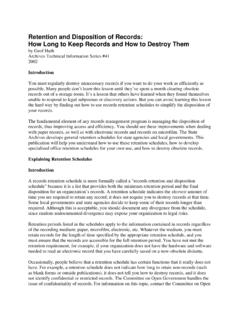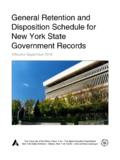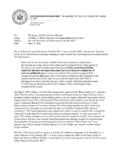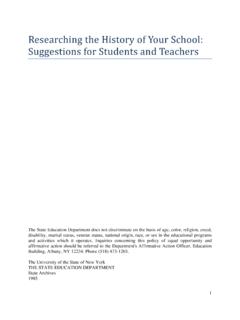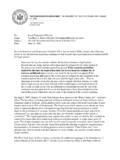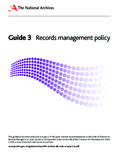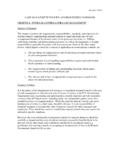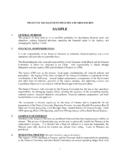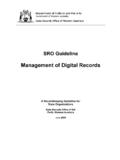Transcription of Guidelines for Choosing Records Management …
1 Guidelines for Choosing Records Management software by Nancy Graham Moreland Publication No. 63 2002 Introduction Records Management software is any computer program designed to systematically control Records within an organization. Such software can help manage Records in any format, and many programs have advanced capabilities for managing electronic Records . However, evaluating, selecting, and purchasing Records Management software depends on several factors. No one system is right for all users, and the system you choose should fit the size and complexity of your organization. Knowing what you need, how the system will be used, and how much it will cost to acquire and maintain, are the factors you must consider when purchasing software . Manual systems (such as card files and typewritten lists) may have been effective in the past, but they rarely meet the requirements of today s fast-paced technological environment.
2 Manual systems are inflexible and prone to error, and they are usually time-consuming and costly. An automated system can provide faster access to data by means of its robust searching capabilities, and is usually easy to learn and update. An automated system will also help you organize your myriad Records , allowing you to capture, manipulate, and manage the data that the Records contain. This publication will help you choose the appropriate Records Management software for your organization. If you choose well, Records Management software can provide many benefits to your organization, including increased productivity, decreased paperwork, greater efficiency, better space Management , and improved customer service and support. This publication will also help you determine what you require (and don t require) of Records Management software ; what you are willing to pay for and what you get for the price; and how to make an intelligent purchase that will achieve the benefits you envision.
3 Please note, however, that the State Archives cannot review, evaluate, endorse, or recommend particular software products. Conducting a Records Inventory As a user, you must first determine what items or activities the Records Management software will manage: active Records , inactive Records , vital Records , historical Records , Records retention scheduling, etc. Identifying your Records Management needs will help you determine exactly what the software must do. Many organizations identify their Records Management needs by first conducting a Records inventory. Such an inventory will determine what and how many Records you have, their physical and environmental condition, how often you refer to them, and where they are currently located. An inventory will also provide a survey of your existing Records situation, determine storage needs, identify vital and archival Records , improve recordkeeping habits, and provide a foundation for a solid Records Management plan.
4 Once you have gathered this important information via an inventory, you can begin to investigate what kind of software will work best for your organization. Determining Your Records Management software Needs Before evaluating and selecting Records Management software to meet your organization s specific needs, you must determine what Records Management functions the software must support, what general functions the software must possess, and what performance criteria the software must meet. Records Management Functions Records Management software can provide many specific Records Management features that you may wish to consider: Destruction notification Monitors and controls destruction of Records Destruction of electronic Records Destroys electronic Records , making them irrecoverable Request processing Captures and manages requests for Records or Records series File and box tracking Tracks the locations and contents of folders and boxes of Records , sometimes by the use of bar coding 2 Files Management Files, stores, retrieves, and updates electronic Records , or maintains information on files of paper Records Document Management Regulates the creation, use, and maintenance of electronic Records General Functions Besides specific Records Management functions, there are many general functions that you should look for in Records Management software .
5 Help features These can include user-friendly online tutorials, easy-to-understand error messages, and support and training by the vendor Menus and commands These should be easy to understand and should be organized in a logical way Speed and accuracy You should be able to enter and retrieve data quickly, with reduced retrieval times Generation of standard reports The software should generate reports easily and print them out as they are seen on the screen Ease of use The software itself should be user-friendly; you should be able to use it the day it is installed Customization You should be able to customize the software to meet the specific needs of your organization without sacrificing the benefits of standard practices Ability to manage Records throughout their life cycle Many organizations purchase software that manages Records throughout their life cycle from creation and active use to inactive use and disposition.
6 Be sure to purchase software that meets your Records life cycle requirements. Ability to manage Records in all formats The software should help you manage Records in any format, if necessary, including paper, electronic, micrographic, and audio-visual Records Free-text searching across fields Any text maintained by the software should allow free-text or keyword searching across fields 3 Security classification and access privileges You should have the ability to assign a security or access classification to either an individual record or a series of Records . The security classification should operate horizontally, according to membership in units or work groups, as well as vertically, according to rank. Ability to track Records movement If necessary, the software should track the movement of Records between users Performance Criteria In addition to supporting essential Records Management activities, the Records Management software you choose should meet these minimum criteria: Must perform on your current computer system.
7 Since not all software works on all computers, you do not want to invest in software that may require additional costly hardware to be compatible Must save in comma-separated American Standard Code for Information Inter-change (ASCII), the most widely used computer coding method. This is necessary to be are able to export data to a new system in the future Must come with vendor-supplied support, maintenance, and training The software package should provide enough vendor support to ensure that you will be able to use the software effectively Test the software It is in your best interest to preview and test available Records Management software packages. Contact vendors and ask them to provide you with information on what is included in their packages, such as the level of support (installation, training, and/or maintenance) and the cost of that support.
8 Vendors may also be available to conduct on-site demonstrations or showcase their products at trade shows, conferences, or meetings. Remember, however, that vendors are trying to sell their products, and they will not necessarily point out the weaknesses of their software . Do not limit your contacts to references provided by the vendors. No vendor would supply a reference from someone dissatisfied with the product. You should test the software on-site if demos or copies of the software are available from the vendor. If you have access to the software at another organization s workplace, test it there. After you test and compare software packages, you can determine which one best serves your needs. You can also seek out information on Records Management software on the New York State Archives website at , or explore reviews or vendor literature on the Internet.
9 4 Questions to Consider When Choosing Records Management software During your search for Records Management software , it will benefit you to ask the following questions about what the software can and cannot do: What Records do I need to manage? You should know exactly what Records you are trying to manage and what problems you are trying to solve. Check with others in your organization about their Records needs to help determine the best software solution. What type of software will meet my needs? There are many kinds of software that support Records Management . Be sure you are looking at the right type of product for your specific needs. What software do other organizations use? Contact other organizations to see what software they use and why, so you can determine what to avoid and what may work for you.
10 Is the manual clear and easy to understand? Vendors should be able to provide you with a copy of the software s manual prior to purchase. The manual should outline how to use the software , and should include information on troubleshooting and contacts for any questions. Examine the table of contents and index for clarity, detail, and comprehensiveness. Make sure you can understand the manual and can use it without difficulty. Is the software easy or difficult to master? The software may be too complicated for your needs. A vendor may tell you that the software can do anything you want but it may also do more than you need. Additional features that you will never use or need will probably cost more. Test the software prior to purchase; if it offers more options than your organization needs, consider other software packages.




